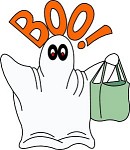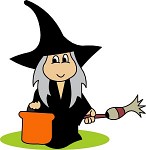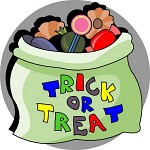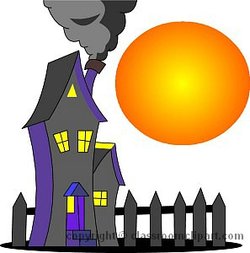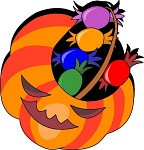Halloween
|
|
Halloween is a holiday celebrated on the night of October 31, usually by children dressing in costumes and going door-to-door collecting candy. It is celebrated in much of the Western world, though most commonly in the United States, Ireland, Scotland and Canada. Irish, Scots and other immigrants brought older versions of the tradition to North America in the 19th century.
The form "Halloween" derives from Hallowe'en, an old contraction, still retained in Scotland, of "All Hallow's Eve," so called as it is the day before the Catholic All Saints holy day, which used to be called "All Hallows," derived from All Hallowed Souls. In Ireland, the name was Hallow Eve and this name is still used by some older people. Halloween was formerly also sometimes called All Saints' Eve. The holiday was a day of religious festivities in various northern European pagan traditions, until it was appropriated by Christian missionaries (along with Christmas and Easter, two other traditional northern European pagan holidays) and given a Christian reinterpretation. Halloween is also known as the Day of the Dead, and it is a day of celebration for Wiccans and other modern pagan traditions, though the holiday has lost its religious connotations among the populace at large.
Halloween is also called Pooky Night in some parts of Ireland, presumably named after the pookah, a mischievous spirit.
In Great Britain in particular, the pagan Celts celebrated the Day of the Dead on Halloween. The spirits supposedly rose from the dead and, in order to attract them, food was left on the doors. To scare off the evil spirits, the Celts wore masks. When the Romans invaded the Britain, they embellished the tradition with their own, which is the celebration of the harvest and honoring the dead. These traditions were then passed on to the United States.
Halloween is sometimes associated with the occult. Many European cultural traditions hold that Halloween is one of the "liminal" times of the year when the spirit world can make contact with the natural world and when magic is most potent (see, for example, Catalan mythology about witches).
Anoka, Minnesota, USA, the self-proclaimed "Halloween Capital of the World," celebrates with a large civic parade.
| Contents |
|
1 Symbols |
Halloween Clipart and Animations
- Halloween Clipart (http://classroomclipart.com/cgi-bin/kids/imageFolio.cgi?direct=Clipart/Halloween)
- Halloween Animations (http://classroomclipart.com/cgi-bin/kids/imageFolio.cgi?direct=Animations/Halloween)
Symbols
Halloween's theme is spooky or scary things particularly involving death, black magic, or mythical monsters. Commonly-associated Halloween characters include ghosts, witches, bats, black cats, goblins, zombies and demons, as well as certain fictional figures like Dracula and Frankenstein's monster. Homes are often decorated with these symbols around Halloween.
Black and orange are the traditional colors of Halloween. There are also elements of the autumn season, such as pumpkins and scarecrows, reflected in symbols of Halloween.
The jack-o'-lantern, a carved vegetable lit by a candle inside, is one of Halloween's most prominent symbols. In Britain and Ireland, a turnip was and sometimes still is used, but emigrants to America quickly adopted the pumpkin because it is much larger and easier to carve. Many families that celebrate Halloween will carve a pumpkin into a scary or comical face and place it on the home's doorstep on Halloween night for fun. Traditionally, something like this was done in order to scare evil spirits away.
Trick-or-treating
The main event of Halloween is trick-or-treating, also known as guising in Scotland, in which children dress up in costume disguises and go door-to-door in their neighborhood, ringing the bell and yelling "trick or treat!" (or, less frequently, "Halloween apples!") The occupants of the house (who might themselves dress in a scary costume) will then hand out small candies, miniature chocolate bars or other treats. Homes sometimes use sound effects and fog machines to help set a spooky mood. Other house decoration themes (that are less scary) are used to entertain younger visitors. Children can often accumulate many treats on Halloween night, filling up entire pillow cases or shopping bags.
In Scotland children or guisers will have to impress the members of the houses they visit with a song, trick, joke or dance in order to earn their treats.
Tricks play less of a role in modern Halloween, though the night before Halloween is often marked by pranks such as soaping windows, egging houses or stringing toilet paper through trees. Before indoor plumbing was so widespread, tipping over or displacing outhouses was a popular form of trick.
Typical Halloween costumes have traditionally been monsters such as vampires, ghosts, witches, and devils. The stereotypical Halloween costume is a sheet with eyeholes cut in it as a ghost costume. In nineteenth-century Scotland and Ireland the reason for wearing such fearsome (and non-fearsome) costumes was the belief that since the spirits that were abroad that night were essentially intent on doing harm, the best way to avoid this was to fool the spirits into believing that you were one of them. In recent years, it has become common for costumes to be based on themes other than traditional horror, such as dressing up as a character from a TV show or movie. In 2001, after the September 11 attacks, for example, costumes of firefighters, police officers, and United States military personnel became popular among children. In 2004, an estimated 2.15 million children in the United States were expected to dress up as Spider-Man, the year's most popular costume. [1] (http://www.nrf.com/content/default.asp?folder=press/release2004&file=costumes1004.htm&bhcp=1)
A program started by UNICEF involves the distribution of small boxes by schools to trick-or-treaters, in which they can collect small change from the houses they visit for donation to the charity.
BIGresearch conducted a survey for the National Retail Federation in the US and found that 54.1 percent of consumers planned to buy a costume for Halloween 2004, spending $28.11 on average. An estimate of $3.12 billion was made for the holiday spending.
A child usually "grows out of" trick-or-treating by his or her teenage years. Teenagers and adults instead often celebrate Halloween with costume parties or other social get-togethers.
Games
There are several games traditionally associated with Halloween parties. The most common is bobbing for apples, in which apples float in a tub or a large basin of water; the participants must use their teeth to remove an apple from the basin. Another common game involves hanging up treacle or syrup-coated scones by strings; these must be eaten without using hands while they remain attached to the string, an activity which inevitably leads to a very sticky face.
Some games traditionally played at Halloween are forms of divination. In [[P?흝 (pronounced "pook-eeny"), a game played in Ireland, a blindfolded person is seated in front of a table on which are placed several saucers. The saucers are shuffled and the seated person then chooses one by touch. The contents of the saucer determine the person's life for the following year. A saucer containing earth means someone known to the player will die during the next year, a saucer containing water foretells travel, a coin means new wealth, a bean means poverty, etc. In nineteenth-century Ireland, young women placed slugs in saucers sprinkled with flour. The wriggling of the slugs and the patterns subsequently left behind on the saucers were believed to portray the faces of the women's future spouses.
In North America, unmarried women were frequently told that if they sat in a darkened room and gazed into a mirror on Halloween night, the face of their future husband would appear in the mirror. However, if they were destined to die before they married, a skull would appear. The custom was widespread enough to be commemorated on greeting cards from the late nineteenth century.
Foods
Because the holiday comes in the wake of the annual apple harvest, candy apples (also known as toffee apples) are a common treat at Halloween. They are made by rolling whole apples in a sticky sugar syrup, and sometimes then rolling them in nuts. At one time candy apples were a common treat given to children, but this practice rapidly waned after widespread rumors that some individuals were embedding items like pins and razor blades in the apples that they would pass out to children. The vast majority of the reported cases turned out to be hoaxes, and the few that were real caused only minor injuries, but many parents were under the assumption that the practice was common. At the peak of this hysteria, some hospitals were offering to x-ray children's Halloween haul at no cost in order to look for such items.
A Halloween custom which has survived unchanged to this day in Ireland is the baking (or more often nowadays the purchase) of a barmbrack (Irish "bᩲ�breac"). This is a light fruit cake into which a plain ring is placed before baking. It is said that whoever finds this ring will find his or her true love during the following year.
Other foods associated with the holiday:
- candy corn
- hot apple cider
- roasted pumpkin seeds
Cultural history
Celtic observation of Samhain
In the Druidic religion of the ancient Celts, the new year began with the winter season of Samhain on November 1. Just as shorter days signified the start of the new year, sundown also meant the start of a new day; therefore the harvest festival began every year on the night of October 31. Druids in the British Isles would light fires and offer sacrifices of crops, animals and sometimes humans, and as they danced around the fires, the season of the sun would pass and the season of darkness would begin.
When the morning of November 1 arrived, the Druids would give an ember from their fires to each family who would then take it home to start a new cooking fire. These fires were intended to keep the homes warm and free from evil spirits such as "Sidhe" (pronounced "shee," most notable of which are the beᮠsidhe or banshees), because at this time of year it was believed that the invisible "gates" between this world and the spirit world were opened and free movement between both worlds was possible.
Bonfires played a large part in the festivities. Villagers cast the bones of the slaughtered cattle upon the flames; the word "bonfire" is thought to derive from these "bone fires." With the bonfire ablaze, the villagers extinguished all other fires. Each family then solemnly lit their hearth from the common flame, thus bonding the families of the village together. Hundreds of fires are still lit each year in Ireland on Halloween night.
Neopagans still celebrate the sabbat of Samhain on Halloween, as well as also taking part in secular Halloween activities.
Halloween customs
Observance of Halloween faded in the South of England from the 17th century onwards, being replaced by the commemoration of the Gunpowder Plot on November 5. However it remained popular in Scotland, Ireland and the North of England. It is only in the last decade that it has become popular in the South of England again, although in an entirely Americanized version.
The custom survives most accurately in Ireland, where the last Monday of October is a public holiday. All schools close for the following week for mid-term, commonly called the Halloween Break. As a result Ireland is the only country where children never have school on Halloween and are therefore free to celebrate it in the ancient and time-honored fashion.
The custom of trick-or-treating is thought to have evolved from the European custom called souling, similar to the wassailing customs associated with Yuletide. On November 2, All Souls Day, Beggars would walk from village to village begging for "soul cakes" - square pieces of bread with currants. Christians would promise to say prayers on behalf of dead relatives helping the soul's passage to heaven. The distribution of soul cakes was encouraged by the church as a way to replace the ancient practice of leaving food and wine for roaming spirits at the Samhain. See Puck (mythology).
In Celtic parts of western Brittany. Samhain is still heralded by the baking of kornigou. Kornigou are cakes baked in the shape of antlers to commemorate the god of winter shedding his "cuckold" horns as he returns to his kingdom in the Otherworld.
"Punkie Night"
"Punkie Night" is observed on the last Thursday in October in the village of Hinton St. George in the county of Somerset in England. On this night, children carry lanterns made from hollowed-out mangel-wurzels (a kind of beet; in modern days, pumpkins are used) with faces carved into them. They bring these around the village, collecting money and singing the punkie song. Punkie is derived from pumpkin or punk, meaning tinder.
Though the custom is only attested over the last century, and the mangel-wurzel itself was introduced into English agriculture in the late 18th century, "Punkie Night" appears to be much older even than the fable that now accounts for it. The story goes that the wives of Hinton St. George went looking for their wayward husbands at the fair held nearby at Chiselborough, the last Thursday in October, but first hollowed out mangel wurzels in order to make lanterns to light their way. The drunken husbands saw the eerie lights, thought they were "goolies" (the restless spirits of children who had died before they were baptized), and fled in terror. Children carry the punkies now. The event has spread since about 1960 to the neighboring village of Chiselborough.
Sources: on-line report from the Western Gazette and a National Geographic radio segment. Chiselborough Fair is memorialized by Fair Place in the village. The National Gazetteer of Great Britain and Ireland (1868) reported that there was "a fair for horses and cattle on the last Thursday in October."
"Mischief night"
The night before Halloween, known in some areas as "Mischief night" or "Devil's Night," is often associated with destructive activities performed by adolescents. Some of the acts range from minor vandalism to theft, or even violence. Many youths involved in mischief night would be considered too old for traditional trick-or-treating. The most common wrong-doing is trashing people's houses, lawns, and trees within property with tons of toilet paper.
A dialect survey (http://hcs.harvard.edu/~golder/dialect/staticmaps/q_110.html) begun in 1999 by Harvard University indicates that there are a number of terms for this particular day of the year, but that the vast majority (70.38%) have no special word for it.
Religious viewpoints
The majority of Christians ascribe no doctrinal significance to Halloween, treating it as a purely secular entity devoted to celebrating imaginary spooks and handing out candy. The secular celebration of Halloween may loom larger in contemporary imagination than does All Saints Day.
The mingling of Christian and pagan traditions in the early centuries following the founding of the Christian Church have left many modern Christians uncertain of how they should react towards this holiday. Some fundamentalist Christian groups consider Halloween a Pagan holiday and may refer to it as "the most evil day of the year," refusing to allow their children to participate. Among these groups it is believed to have developed Satanic influences. In some areas, complaints from these fundamentalist Christians that the schools were endorsing a Pagan religion have led the schools to stop distributing UNICEF boxes.
Other Christians, however, continue to connect this holiday with All Saints Day. Some modern Christian churches commonly offer a "fall festival" or harvest-themed alternative to Halloween celebrations. Still other Christians hold the view that the holiday is not Satanic in origin or practice and that it holds no threat to the spiritual lives of children.
External links
- Halloween origins; Australian customs (http://www.wilsonsalmanac.com/halloween.html)
- Halloween in France (http://french.about.com/library/bl-halloweeninfrance.htm)
- An example of an unusual Halloween decoration theme (http://www.komar.org/halloween/)
- Various Christian Views of Halloween from a Calvinist perspective (http://www.theopedia.com/Halloween)
- Snopes' Urban Legends reference page on the hysteria about pins and razor blades being found in Halloween candy (http://www.snopes.com/horrors/mayhem/needles.htm)


